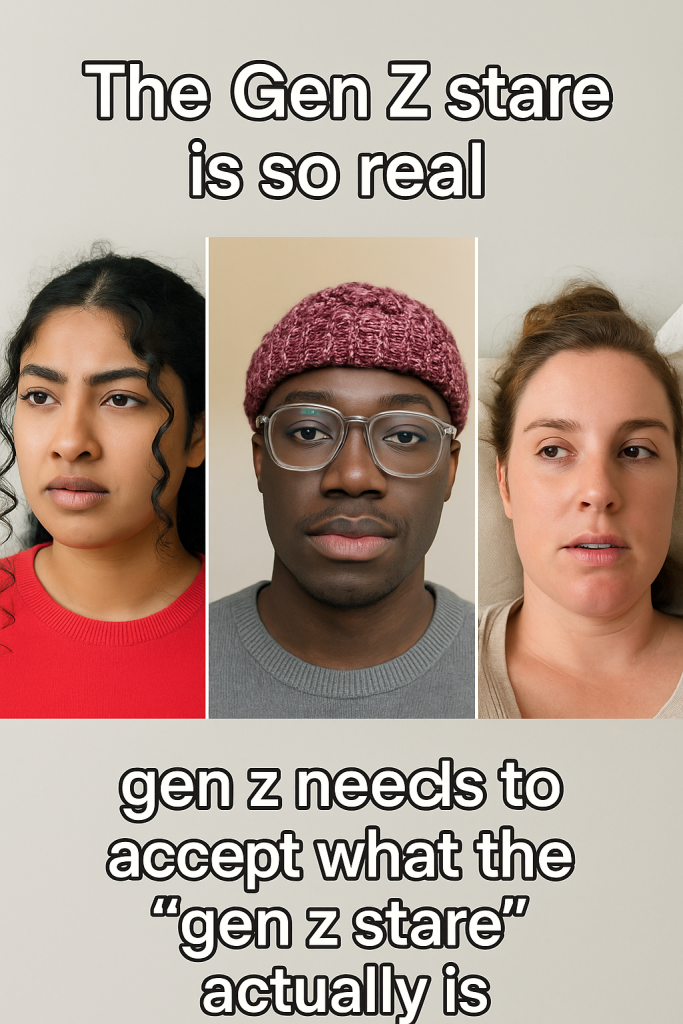In the continually evolving landscape of generational identity and social media trends, a new expression called the “Gen Z stare” has surged into public consciousness, sparking intense debate between Millennials and Zoomers alike. But what exactly is the Gen Z stare, and why is it causing such a rift between these two closely linked generations?
At its core, the Gen Z stare refers to a specific facial expression commonly seen in photos and videos circulating on platforms like TikTok and Instagram. Characterized by a neutral, almost deadpan gaze—often with slightly widened eyes and a subtle tension in the face—this look is intentionally detached yet intriguingly engaging. Unlike the wide smiles or dramatic poses favored by Millennials on social media, the Gen Z stare is minimalist and cryptic, evoking a sort of emotional ambiguity that many Zoomers use to convey complexity, irony, or even existential commentary.
This visual trend has escalated into a kind of cultural symbol, representing how Gen Z views self-expression and internet presence. It’s often interpreted as an emblem of “authenticity through neutrality,” signaling a rejection of the hyper-enthusiastic and curated personas that Millennials typically preferred in earlier social media eras.
However, the rise of the Gen Z stare has generated controversy. Many Millennials, now in their late 20s to late 30s, have expressed confusion and even frustration, perceiving this expression as cold, uninviting, or overly ironic. For Millennials, social media has traditionally been about connection and warmth — think Instagram selfies, candid moments, and overt emotional cues — while the Gen Z stare can come across as deliberately unapproachable or enigmatic.
Across various social media discussions and comment threads, this difference in aesthetic and attitude has compounded generational misunderstandings. Some Millennials accuse Zoomers of fostering a culture of detachment or apathy, while many Zoomers defend the stare as a reflection of contemporary emotional complexity in a world saturated with anxiety and uncertainty.
Experts on generational communication say the divide goes deeper than a facial expression. The Gen Z stare encapsulates broader shifts in how young people relate to each other and the digital world. While Millennials grew up navigating the early days of social media with a desire to present aspirational, often idealized versions of themselves, Gen Z tends to prioritize emotional transparency, relatability, and a sometimes sardonic take on internet culture. The stare’s blankness is not emptiness but a nuanced nonverbal cue that has grown alongside memes, ironic humor, and a preference for subtlety over overt emotional display.
Furthermore, the Gen Z stare symbolizes how younger generations handle mental health and vulnerability. Many who adopt the stare online use it to express feelings of uncertainty, overwhelm, or social fatigue, all packaged in a manner that feels authentic to their lived experiences. In contrast, Millennials’ focus on positivity and self-presentation might feel increasingly less genuine to Zoomers, deepening the generational divide.
Social media algorithms and trends have amplified this debate, often pitting Millennials and Zoomers in playful but persistent battles over “who understands cultural expression better.” The Gen Z stare has become more than an aesthetic choice—it’s a flashpoint in wider intergenerational conversations about identity, communication, and emotional honesty in the digital age.
In the end, whether you find the Gen Z stare compelling or puzzling, it reflects a fundamental change in how new generations communicate visually online. It highlights the growing complexity of expressing selfhood in an era where every glance, gesture, and expression is scrutinized, recreated, and shared worldwide in seconds.
As the trend continues to unfold, bridging understanding



